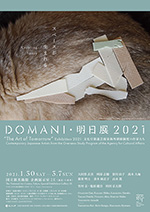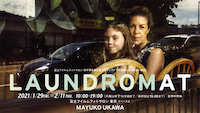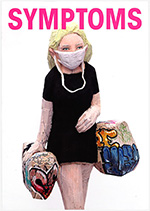 |
Picks is a monthly sampling of Japan's art scene, offering commentary by a variety of reviewers about exhibitions at museums and galleries in recent weeks, with an emphasis on contemporary art by young artists.
Note: Most of Japan's museums and galleries have reopened, but conditions and anti-coronavirus precautions vary. If you are planning a visit, please check the venue's website beforehand. |
 |
 |
|
|
 |
 |
 |
 |
| Kikuji Kawada: Endless Map |
| 20 January - 10 April 2021 |
PGI
(Tokyo) |
 |
|
Kawada (b. 1933) is one of a number of photographers who constantly revisit and revise works they published or exhibited in the past. Another was Shomei Tomatsu (1930-2012), who would reprint images from his previous photo books in new sequences and layouts. Kawada, who together with Tomatsu and others founded the photography collective VIVO in 1959, seems to share that predilection, having subjected the prints making up his most famous series, The Map (1965), to frequent revisions over the years. The Map has indeed become "endless," as the title suggests, but in the process its images have acquired sharper definition and disclosed more secrets.
|
|
|
 |
 |
|
| Kazuyuki Kawaguchi: Prospects Vol. 5 |
| 5 - 21 February 2021 |
Photographers' Gallery
(Tokyo) |
 |
| Kawaguchi has been exhibiting an ongoing photo series, Prospects, at this gallery for the past several years. In its fifth installment, a theme or motif of sorts seems to emerge for the first time. The photographer explains that he became interested in capturing "rainy day" scenes after being caught in a downpour while filming the town of Okegawa north of Tokyo. Most of the images on display here were shot in the rain, a strategy that proves successful as it gives these forlorn townscapes a damp, leaden gleam and a poignant air of déjà vu. |
|
|

|
 |
 |
 |
|
"Domani: The Art of Tomorrow" Exhibition 2021 |
| 30 January - 7 March 2021 |
The National Art Center, Tokyo
(Tokyo) |
 |
|
Domani introduces contemporary Japanese artists from the government's Overseas Study Program. Last year's iteration was meant to dovetail with the Tokyo Olympics and Paralympics, but those got postponed and now even their opening this summer is in doubt. The pandemic also stymied international travel and exchange, forcing programs like this one to adjust to a new normal. This year, however, the exhibition reappears in physical form, featuring seven newcomers and three now-successful past participants. With the ten artists evenly divided between men and women, and two women (curator Yoko Hayashi and museum director Eriko Osaka) at the helm, the show may have a thing or two to teach Japan's sports, business, and political establishments about gender balance.
|
|
|
 |
 |
|
| Société Irf Moves Forward: Avant-Garde Photographs and Paintings of Fukuoka |
| 5 January - 21 March 2021 |
Fukuoka Art Museum
(Fukuoka) |
 |
| Société Irf was an avant-garde art group that was founded in Fukuoka in 1939, but only remained active until the onset of World War II. The first thorough retrospective of Irf's activities was a 1987 show at this museum, Avant-garde Photographers in Fukuoka: Société Irf. Now, over three decades later, the current show at the same venue is a welcome reexamination of this important group. Though its life was short, Irf's contributions to avant-garde Japanese photography rank with those of the more prominent prewar movements based in Osaka and Nagoya.
|
|
|
|
|
|
|
|

|
 |
 |
 |
|
| Mayuko Ukawa: Laundromat |
| 29 January - 11 February 2021 |
FujiFilm Photo Salon
(Tokyo) |
 |
| An exhibition about the laundromats of New York City. Photographer Ukawa first visited New York when she was 19, and was struck by the practice of art there that interacts with the city and its inhabitants. In 2018 she began photographing laundromats, an ubiquitous presence in New York, where many households lack their own washing machines. Ukawa would strike up conversations with other patrons and take their picture while doing her own laundry. |
|
|
 |
|
| Junko Maruyama: Alive And |
| 4 - 11 February 2021 |
Galerie Paris
(Kanagawa) |
 |
| Installation artist Maruyama, who has a studio in BankArt's R16 complex in Yokohama, held this solo show before departing for a sojourn in Germany. She built some simple shelves along the walls of the gallery and filled them with a number of objects constructed by binding found materials like tree branches, wire, pottery shards, and bits of plastic together with rope or wax. The works on display shared several aspects in common: the use of discarded items, an ugly-is-beautiful aesthetic, and a resemblance to the work of Joseph Beuys.
|
|

|
 |
 |
 |
 |
|
Hideki Iinuma: Symptoms |
8 January - 6 February 2021 |
SNOW Contemporary
(Tokyo) |
 |
| A solo presentation by an artist known for his painted wood sculptures of women. Before the gallery entrance stands a figure of a woman carrying a large bag in each hand. Two elements that catch the eye are the white mask she is wearing, and the graffiti painted on the bags. What's interesting is that Iinuma was able to carve the mask, but had to apply the graffiti to the wood surface. In other words this is a multimedia work of both sculpture and painting. |
|
|
 |
 |
|
| Hiroko Komatsu + Tatekawa Kiyoshiro: Ocular Inverse Transgression |
| 4 - 21 February 2021 |
MEM
(Tokyo) |
 |
| An intriguing joint effort by two media artists. Komatsu films her own installations of photos of construction material storage sites, while Tatekawa produces a constant stream of still photos and videos of subjects with a highly physical presence. Industrial scrap piles and zoos alike can be described as places left behind by the global network of capitalist society. Rather than milk these images for their symbolic value, however, both artists emphasize their physicality by displaying them on large sheets of photographic paper or projecting them on theater curtains. |
|
|
|
|
|
|
 |
|
| Azami Photo Annual: What We See When We Pause |
| 23 January - 14 February 2021 |
Yokohama Civic Gallery Azamino
(Kanagawa) |
 |
| This year, Azami Photo Annual showcased seven photographers. They offered shots of cardboard-painted "landscapes"; reconstructions of "fragmentary tales of catastrophe" such as earthquakes and eruptions; photomontages of portraits of fictitious "deceased travelers"; everyday spaces recreated with digital tools; images of "miniature houses" propagated during the pandemic; "pictures without proper nouns" made from photos found in regional newspapers; and superpositions of images from the internet with mountains visited by the photographer. The show was impressive for its deft arrangement of works produced by such broadly diverse methods.
|
|
 |
 |
|
| Forms for Fragrance: Treasures from the Takasago Collection |
| 9 January - 21 March 2021 |
Panasonic Shiodome Museum of Art
(Tokyo) |
 |
|
A term like "fragrance container" immediately conjures up images of perfume bottles, but as this show illustrated, vessels made for fragrances over the centuries vary dramatically between West and East. Perfumes may dominate in the West, but Japan boasts incense burners, incense boxes, and even incense pillows. The forms taken by the scents themselves range from essential oils extracted with alcohol to aromatic woods and ash. These marked differences in the culture of fragrance from region to region persist today.
|
|
|
|
|
 |
|